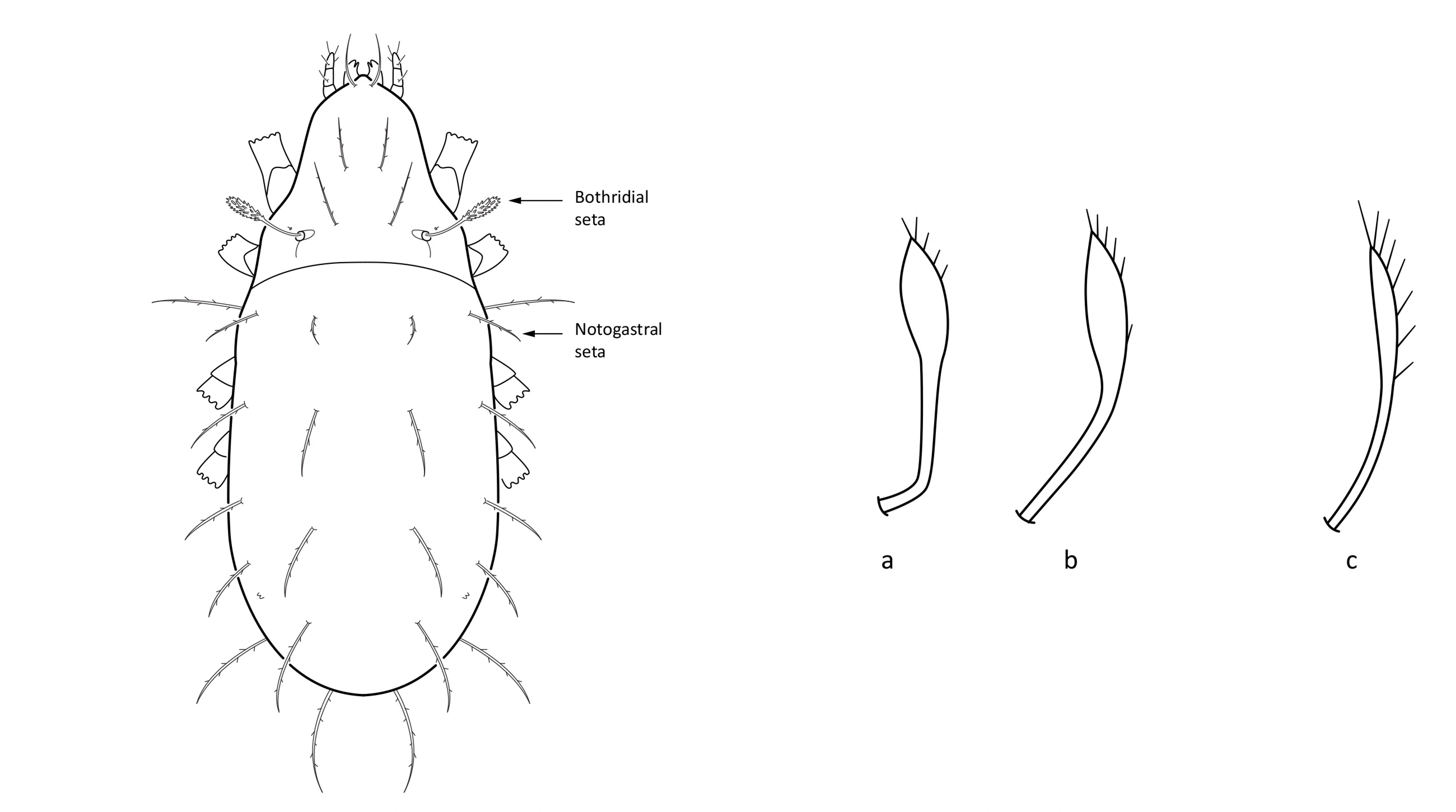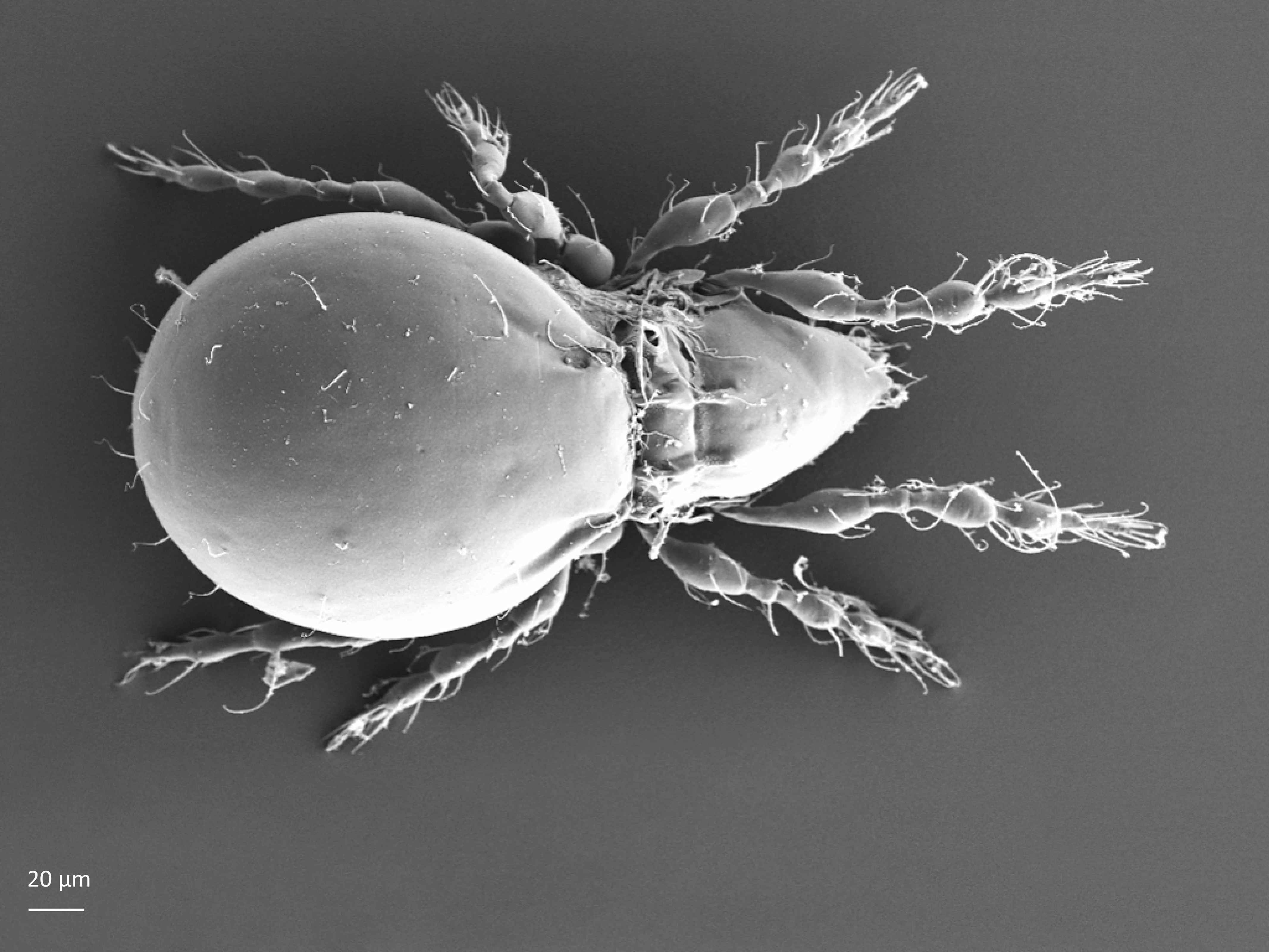Oppiella nova
Oppiella nova is one of the most common oribatid species in Norway, and world-wide. It is found abundantly in different nature types, and most often in the soil. Its body size varies depending on the environmental conditions. It eats only fungi and reproduces parthenogenetically, females are produced from unfertilized eggs.
Description

Fig. 1. Dorsal view of Oppiella nova, adult.
Adult: The length of the body is 220–357 µm, and the width is 130–186 µm. The color is light brown. The prodorsum has distinct parallel lamellar costulae (longitudinal ridges similar to lamellae, but without projecting edges or cusps), extending diagonally to the bothridial setae (Fig. 1). There is a transversal ridge between the parallel costulae. The bothridial seta is long, very slim, spindle-shaped, and with small cilia on one side. The notogaster has two pairs of cristae (marked by arrowhead in Fig. 1) at the anterior margin, and 10 pairs of short setae (Weigmann 2006).
Juvenile stages: Larva: body length 150 µm, width 79 µm. Protonymph: body length 171 µm, width 84 µm. Deutonymph: body length 187 µm, width 91 µm. Tritonymph: body length 219 µm, width 110 µm. The color is whitish, and the body surface is rough, but without any sculpture of the skeleton, that is characteristic of adults. The bothridial seta is spindle-like with a thorny head, notogastral setae are relatively longer (in comparison to body size) than in adults (Fig 2) (Seniczak 1972).

Fig. 2 (left). Dorsal view of Oppiella nova, nymph.
Fig. 3 (right). Bothridial seta in Oppiella uliginosa (a and b) and in Oppiella nova (c).
Look-alikes
Oppiella nova is similar to O. uliginosa (Willmann, 1919), but its bothridial setae are long, very slim, spindle-shaped (Fig. 3c), with cilia on one side. Oppiella uliginosa has thickened, spindle-shaped bothridial setae, with 5–6 short cilia on one side at the distant end (Figs. 3 a and b).
Biology
Reproduction is parthenogenetic, only females are present and they are produced from unfertilized eggs. Development time from egg to adult is 60 days in 15 °C, 34 days in 20 °C and 23 days in 25 °C. Oppiella nova is strictly fungivorous, it eats only fungi.
Ecology
Distribution
Oppiella nova is cosmopolitan (Subías 2004), it is found world-wide.
Habitat
The species is extremely eurytopic (occurs in many different habitat types), and is often numerous. It is mainly found in soils, where it shows a tendency to occupy deeper soil layers. It is also found on trees and other plants, on lichens, stones and walls. Large morphological variation in body size is prominent in this species and depends on the environmental conditions. As an example, individuals from grasslands were larger than those from forests (von Saltzwedel et al. 2014).
Findings in Norway
Oppiella nova is very common in Norway. It has been found in nearly all studied nature types: in forests (Hågvar and Abrahamsen 1980, Hågvar and Kjøndal 1981, Thunes et al. 2004), bogs (Seniczak et al. 2010), in the glacier foreland of central south Norway (Seniczak et al. 2006, Hågvar et al. 2009), and in the arctic tundra in Svalbard (Seniczak and Seniczak 2020, Seniczak et al. 2020).
References
Hågvar S and Abrahamsen G (1980). Colonisation by Enchytraeidae, Collembola and Acari in sterile soil samples with adjusted pH levels. Oikos 34, 245–258.
Hågvar S and Kjøndal BR (1981). Effects of artificial acid rain on the microarthropod fauna in decomposing birch leaves. Pedobiologia 22, 409–422.
Hågvar S, Solhøy T and Mong CE (2009). Primary succession of soil mites (Acari) in a Norwegian glacier foreland, with emphasis on oribatid species. Arctic,. Antarctis and Alpine Research, 41, 219–227. doi.org/10.1657/1938-4246-41.2.219
Maraun M, Caruso T, Hense J, Lehmitz L, Mumladze L, Murvanidze M, Nae I, Schulz J, Seniczak A and Scheu S (2019). Parthenogenetic vs. sexual reproduction in oribatid mite communities. Ecology and Evolution 9(12), 7324–7332. doi.org/10.1002/ece3.5303
Seniczak A and Seniczak S (2020). Diversity of oribatid mites (Sarcoptiformes) in the Svalbard Archipelago: a historical overview. Zootaxa 4834 (1), 041–065. doi.org/10.11646/zootaxa.4834.1.3.
Seniczak A, Seniczak S, Schwarzfeld MD, Coulson SJ and Gwiazdowicz DJ (2020) Diversity and Distribution of Mites (Acari: Ixodida, Mesostigmata, Trombidiformes, Sarcoptiformes) in the Svalbard Archipelago. Diversity 12, 323; doi:10.3390/d12090323
Seniczak A, Solhøy T and Seniczak S (2006). Oribatid mites (Acari: Oribatida) in the glacier foreland at Hardangerjøkulen (Norway). Biological Letters 43(2), 231–225.
Seniczak A, Solhøy T, Seniczak S and Riva-Caballero A (2010). Species composition and abundance of the oribatid fauna (Acari, Oribatida) at two lakes in the Fløyen area, Bergen, Norway. Biological Letters 47(1), 11–19. doi.org/10.2478/v10120-009-0014-0
Seniczak S (1972). Morphology of the developmental stages of Oppia ornata (Oudem.) and Oppia nova (Oudem.) (Acarina, Oribatei). Bulletin de la Société des amis des Sciences et des letters de Poznań, Serié D 12/13, 181–196
Subías LS (2004). Listado sistemático, sinonímico y biogeográfico de los ácaros oribátidos (Acariformes, Oribatida) del mundo (excepto fósiles). Graellsia 60 (número extraordinario), 3–305.
Thunes KH, Skartveit J, Gjerde I, Starý J, Solhøy T, Fjellberg A, Kobro S, Nakahara S, zur Strassen R, Vierbergen G, Szadziewski R, Hagan DV, Grogan Jr WL, Jonassen T, Aakra K, Anonby J, Greve L, Aukema B, Heller K, Michelsen V.,Haenni J-P, Emeljanov AF, Douwes P, Berggren K, Franzen J, Disney RHL, Prescher S, Johanson KA, Mamaev B, Podenas S, Andersen S, Gaimari SD, Nartshuk E, Søli GEE, Papp L, Midtgaard F, Andersen A, von Tschirnhaus M, Bächli G, Olsen KM, Olsvik H, Földvári M, Raastad JE, Hansen LO and Djursvoll P (2004). The arthropod community of Scots pine (Pinus sylvestris L.) canopies in Norway. Entomologica Fennica 15, 65–90.
von Saltzwedel H, Maraun M, Scheu S and Schaefer I (2014). Evidence for frozen-niche variation in a cosmopolitan parthenogenetic soil mite species (Acari, Oribatida). PLoS ONE 9(11), e113268. doi.org/10.1371/journal.pone.0113268
Weigmann G (2006). Hornmilben (Oribatida). Die Tierwelt Deutschlands. 520 pp. Vol. 76, Goecke and Evers, Keltern.
Siden siteres som:
Seniczak A. Oppiella nova (Oudemans, 1902). www.artsdatabanken.no/Pages/286331. Nedlastet <dag.måned.år>.
